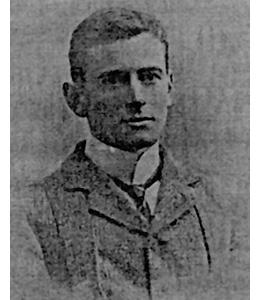Killed in an explosion at Silvertown aged 40
Buried at the East London Cemetery
Andrea (papers refer to him also as Andreas and Andrew) was born in Bradford, the son of Thomas Angel, an Inland Revenue Supervisor, and his wife Angelina, the daughter of St George Stock, a University Lecturer and philosopher.
He was educated at Exeter School and won an exhibition to Christ Church, Oxford graduating with a First in 1899. He subsequently became an MA in 1903, and was awarded a BSc (today an MSc) “for his brilliant research work”. He then became a Chemistry lecturer at Brasenose and Keble Colleges before returning to Christ Church to run its laboratory as a Tutor and Lecturer in Chemistry.
In 1904 he married Mary Letitia Stock in Headington and they had two daughters. Andrea volunteered for war work and was recruited near the beginning of the First World War by the Brunner Mond Company to oversee TNT processing.
“On Friday 19th January 1917 at 6.52pm a huge explosion ripped a large area of Silvertown from the face of the Earth. The sound was heard and the shock-wave felt all over London and Essex, it was heard over 100 miles away as far as Southampton and Norwich. The fires that followed were seen 30 miles away from as far as Guildford and Maidstone. This is the basic story of that disastrous event, the largest explosion ever to occur anywhere near London.
“In 1893, a chemical works was established at Crescent Wharf in Silvertown, Essex, now east London - and part of Newham - by a company named Brunner Mond Ltd. The factory produced mainly soda crystals with a smaller plant producing caustic soda. The caustic soda production was halted in 1912 and that part of the plant was closed and went un-used up to the outbreak of The Great War.
“At this point, because of the great demand for munitions by the government’s ‘Explosives supply Department’ led by Lord Moulton, pressure was put on Brunner Mond’s management to place the plant back into production, this time purifying TNT… So despite the reluctance of the company and the high population density surrounding the area, production began in September 1915.
“The explosion itself was believed to have been caused by approximately 50 tons of TNT (much of it loaded into nearby railway wagons awaiting transport out of the plant) being set off by a fire in the ‘melt-pot’ room and a large part of the Brunner Mond factory instantly disappeared, many buildings immediately surrounding the location were immediately demolished. The blast started fires for miles around by large, red hot lumps of flying metal blown from the factory building. In all it was estimated 60 to 70 thousand properties received damage costing £2,500,000, a huge amount of money at that time. Seventy-three people lost their lives (sixty-nine immediately) and over four hundred were injured - this is a small number considering the size of the blast, due mainly to the time of day it took place and the fact it was the end of the ‘working week’.
“Immediate response came from all quarters - ambulance, fire service, police, charities, council etc. helped the stunned locals in coping with the disaster and many acts of heroism and stories of lucky escapes were reported. It is known that a number of men were fighting the fire when the TNT exploded, they included chief chemist and Oxford don, Andreas Angel, who was a war-work volunteer, he received a posthumous Edward Medal.” (The Edward Medal was replaced in 1941 by The George Cross)
On 27 January 1917 The Stratford Express stated in its editorial column that: “First and foremost, there is the heroic conduct of Dr Angel whose body has at last been found amongst the ruins of the factory. Had he been a craven coward he might possibly have escaped with his life, but like a true English gentleman – knowing full well the potentialities of such a fire at the factory – he remained on the spot where he felt his duty to be.”
The former TNT factory's grounds are, as of 2010, empty, not having been built upon since the explosion A memorial was commissioned by Brunner Mond in the 1920s inside the entrance to the factory location; it also serves as a memorial to those who fell in both World Wars.
His Estate amounted to £374 18s. 3d. Probate granted 3rd May 1917 to Mary Leticia Angel, Widow, of 15 Banbury Road Oxford.

